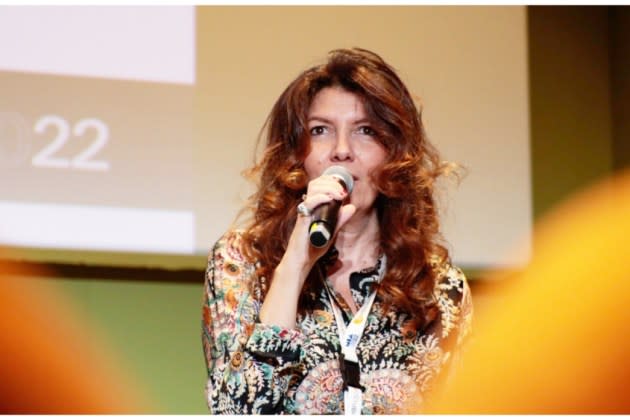Rome MIA Chief Gaia Tridente Talks This Year’s Focus on ‘Inclusion and Diversity’ Within the Market

Rome’s upcoming MIA market dedicated to international TV series, animation, feature films and documentaries is set to run Oct. 9-13 in central Rome’s Palazzo Barberini, which besides being Italy’s National Ancient Art gallery, is also the market’s main hub.
Now at its ninth edition, this innovative pre-Mipcom event (the MIA acronym stands for the Mercato Internazionale Audiovisivo or International Audiovisual Market) aims to boost the Italian industry by strengthening its international ties. It will feature 62 projects of all shapes and sizes from 36 countries with an accent on “inclusion and diversity,” says its director Gaia Tridente.
More from Variety
Acclaimed Animator Anca Damian Lines Up Live-Action Feature 'First People on Earth' (EXCLUSIVE)
Italian Content Production Worth $1.9 Billion as U.S. Streamer Investments Grow, Says MIA Report
As previously announced, MIA has recruited a roster of high-caliber speakers at MIA that includes Nicole Clemens, president of Paramount Television Studios and Paramount+ original scripted series; Sara Bernstein, president of Brian Grazer and Ron Howard’s Imagine Documentaries; Marge Dean, head of Skybound Entertainment’s animation studio and president of Women in Animation; “Waltz With Bashir” director Ari Folman; and James Townley, chief content officer of development at Banijay.
Below, Tridente speaks with Variety about the novelties in store this year.
MIA seems to be evolving. What’s new?
We’ve worked on assembling a program that I like to define as “MIA Expanded.” A market that builds on MIA’s foundations and comprises all formats. Last year, we launched our animation section as what you could call a pilot program. It worked very well and has attracted big animation players. We’ve since forged partnerships with other animation markets, like Anneny’s MIFA. As soon as I heard that Marge Dean had been nominated head of Skybound’s new animation studio, I reached out and she will be coming to represent adult animation, which is one of the top animation strands right now.
But we are also moving toward extended reality content. This year within Palazzo Barberini, we will have a MIA XR Tech Pavilion and we have VR Rooms. It’s all part of our efforts to open up to new forms of storytelling and create links between them.
Though MIA remains Eurocentric, it now has a greater geographic reach. How did this happen?
We’ve seen a 30% increase in the number of countries, now 81, that submitted more than 500 projects to the co-production market. The 61 projects that we selected are from 36 countries and Europe, of course, stands out. But what I can tell you is that, especially in the animation section, we have projects from Ghana, Mexico, Egypt, South Africa, alongside European ones. This reflects the fact that this year we’ve worked on inclusion and diversity — not just in our project selection, but also in our board and selection committees. Increased geographic diversity is visible across our entire project selection, including our content showcases that this year, for the first time, are open to global – not just Italian – content. And we’ve expanded our B2B Exchange scheme, launched last year to support the Ukrainian TV and Film Industry to other countries including Egypt, Sudan, Lebanon, Morocco and Congo.
Co-productions, which are at the core of MIA, are more crucial than ever. What’s your take on why they are gaining more importance?
Ultimately, it boils down to production budgets being slashed across the board, whether it’s streamers or public or private broadcasters, both in TV and cinema. The co-production model is making a comeback and plays a different role — especially on ambitious, big-budget projects — because the more players you can get around a table, the more odds you have of getting it off the ground. This means adopting business models that used to just be applied to indie movies and are now instead an integral part of the financial packaging of TV series. Producers on series are taking a bigger share of the risks and holding on to a greater share of the rights. At the same time, the role of international distributors is changing. Whereas distributors used to be the final link in the chain by selling finished product on the market, distributors now board projects at a much earlier stage, so distribution companies have hired people to do creative development. And let’s not forget that there are companies active in distribution that are buying up production companies [such as France’s Vuelta Group that recently purchased Italy’s Indiana Production].
As MIA evolves, how do you see its function on the film distribution side? Has this aspect changed?
While we’ve worked hard on becoming an innovative co-production market, we have always also strived to bolster our role as a market for finished theatrical product. We strongly believe that with AFM faltering, MIA can be an important fall European film market of this type. That’s why we have a special curated program for buyers called the MIA Buyers Club, along with market screenings. There are plenty of buyers coming to Rome, partly thanks to our collaborations with top promotional entities such as Unifrance, German Films and Unefa (Union of Film and Audiovisual Exporters). The difference is that this year we’ve introduced a new section, called Comin’up, where buyers can discover work-in-progress feature films. We also have the See U Soon showcase section for finished titles seeking an international distributor. As you know, sales take place at different stages of a project’s cycle and MIA is now covering all these stages.
Best of Variety
Sign up for Variety’s Newsletter. For the latest news, follow us on Facebook, Twitter, and Instagram.
